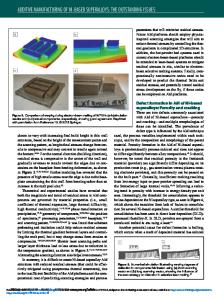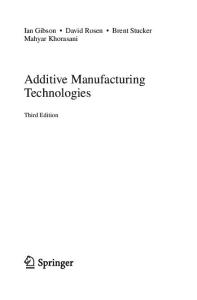Software Issues for Additive Manufacturing
It is clear that Additive Manufacturing would not exist without computers and would not have developed so far if it were not for the development of 3D solid modeling CAD. The quality, reliability, and ease of use of 3D CAD have meant that virtually any ge
- PDF / 548,369 Bytes
- 21 Pages / 439.37 x 666.142 pts Page_size
- 124 Downloads / 1,114 Views
Software Issues for Additive Manufacturing
13.1
Introduction
It is clear that Additive Manufacturing would not exist without computers and would not have developed so far if it were not for the development of 3D solid modeling CAD. The quality, reliability, and ease of use of 3D CAD have meant that virtually any geometry can be modeled, and it has enhanced our ability to design. Some of the most impressive models made using AM are those that demonstrate the capacity to fabricate complex forms in a single stage without the need to assemble or to use secondary tooling. As mentioned in Chap. 1, the WYSIWYB (What You See Is What You Build) capability allows users to consider the design with fewer concerns over how it can be built. Virtually every commercial solid modeling CAD system has the ability to output to an AM machine. This is because the only information that an AM machine requires from the CAD system is the external geometric form. There is no requirement for the machine to know how the part was modelled, any of the features or any functional elements. So long as the external geometry can be defined, the part can be built. This chapter will describe the fundamentals for creating output files for AM. It will discuss the most common technique, which is to create the STL file format, explaining how it works and typical problems associated with it. There are numerous software tools for use with AM and there will follow a description of some of these and finally there will be a discussion on how new concepts in AM may affect the development of associated software tools in the future.
13.2
Preparation of CAD Models – the STL File
The STL file is derived from the word STereoLithography, which was the first commercial AM process, produced by the US company 3D Systems in the early 1980s [1], although some have suggested that STL should stand for Stereolithography I. Gibson, D.W. Rosen, and B. Stucker, Additive Manufacturing Technologies, DOI 10.1007/978-1-4419-1120-9_13, # Springer ScienceþBusiness Media, LLC 2010
341
342
13 Software Issues for Additive Manufacturing
Tessellation Language. STL files are generated from 3D CAD data within the CAD system. The output is a boundary representation that is approximated by a mesh of triangles.
13.2.1 STL File Format, Binary/ASCII STL files can be output as either binary or ASCII (text) format. The ASCII format is less common but easier to understand and is generally used for illustration and teaching. Most AM systems run on PCs using Windows. The STL file is normally labeled with a “.STL” extension that is case insensitive, although some AM systems may require a different or more specific file definition. These files only show approximations of the surface or solid entities and so any information concerning the color, material, build layers, or history is ignored during the conversion process. Furthermore, any points, lines, or curves used during the construction of the surface or solid, and not explicitly used in that solid or surface, will also be ignored. An STL
Data Loading...











